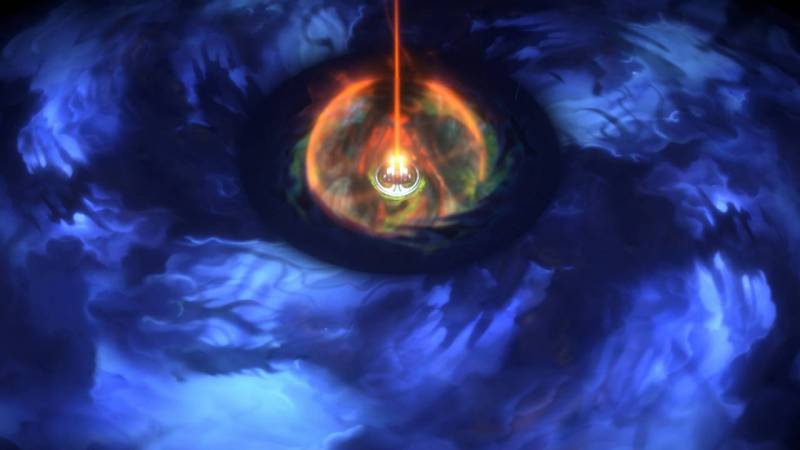The Lowdown
At 20 bucks, I’d definitely recommend giving this a look if you like settlement builders, RNG or rogue mechanics, and/or appealing visuals (the settlers are so darn cute). Against the Storm isn’t the most complicated of games out there, but it does what it does well and hopefully should only get better as more get added. Keep up the good work, Eremite Games!
Overall
Pros
- The randomness is balanced, as you can typically find your way out of a jam with regularity if you think
- Community engagement during the development process
- Polished experience with cute visuals
Cons
- Needs more variety in a few elements to keep people engaged long term
- Some systems are a bit too shallow at this time, e.g., mining, blightrot, farming
You gaze into the sunrise as the blightstorm and barrier fade away. Terrible yet beautiful, it has once again scoured the land and reduced all you have toiled for into naught but ash and ruin. The cycles are unending, an inferno that knows no mercy. But it’s time; time to set out into a world striving to repel your very existence and forage fuel to keep the fires burning. You are not deterred. You are loyal to your people and to your Queen. You are the bending reed amidst the hurricane.
Against the Storm, you will not be broken.
I’ve been playing this game for about 48 hours; here are my thoughts.
Despite my poetic whimsy, Against the Storm is, at its core, a settlement builder. You might have read about it from my Steam Next Fest 2022 article, but the game is available on Steam now in Early Access.
For those who don’t know, Early Access is the time period in which a game is still being developed yet available for purchase. In theory, this gives developers unadulterated access to a pool of avid and passionate people who not only provide valuable feedback on what currently is/isn’t working but also what they would like to see as the game matures.
I say “in theory,” dripping with implication because some studios never actually leave Early Access and instead seemingly leave their game to fester on the vine, riddled with bugs and stagnation. “It’ll be fine, it’s still in early access! Give us more money to fix these problems,” these hereby unnamed folks blast out across the internet. I’m sure they have a bridge to sell you while they’re at it.
However, that is NOT the case here! The folks over at Eremite Games/Hooded Horse are running updates every two weeks or so, introducing new content, tweaking old, and squashing bugs. It’s an ambitious schedule, and they very clearly communicate the roadmap in the opening screen of the game itself. It’s entirely possible by the time you read this review, it may be an entirely different experience, but spoiler alert: I don’t think you should be concerned.
For archival purposes, I’m playing this mostly around the “Royal Archaeologist Update” (Early Access Build v0.37.3R) and the “Lighthouse Update” (Early Access Build v0.28.2R).
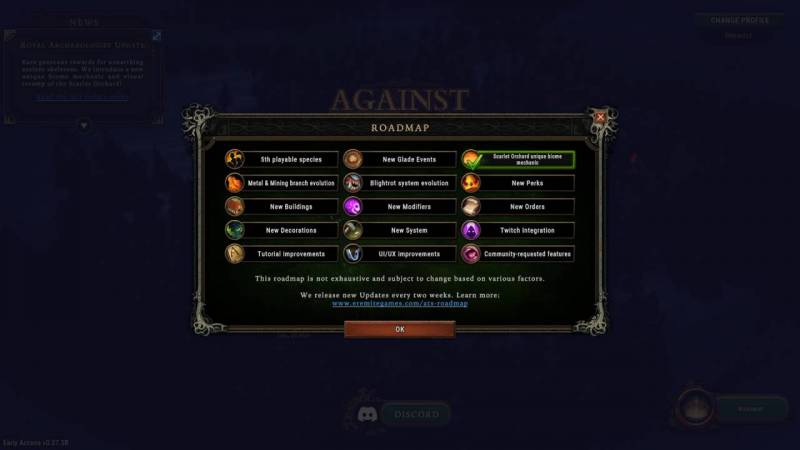
This gets my blood pumping
Before we get into the main Against the Storm rundown, I wanted to give a quick shoutout to the Developer and Publishing Team for providing me with a code for this game. I really appreciate the generosity, as well as being available to answer some questions I had during the review process.
Let’s do a little bit of education first, what do we mean when we say a game has “rogue” elements?
In general, this means that each playthrough (or “run”) is composed of the same structure, but the components you get to use are drawn from a larger pool and are selected at random. This means that it is statistically almost impossible to get the same combination of features twice. Your maps will be randomized, your unlockable abilities/items will be randomized, and your challenges/enemies will likewise be randomized.
As you play more, you typically acquire currency that you can spend at a “hub” to give you small permanent extra benefits to make your future “runs” more manageable. Games in this genre have grown increasingly popular over the years, notable examples being Hades, The Binding of Isaac, and even Vampire Survivors.
These are vastly different in terms of mechanics, but they all follow this structure of selected randomness from a larger pool. This chaos and figuring out how to achieve victory as best you can appeal to me, and my Steam library is STACKED with titles like this.
Now let’s chat about settlement builders.
To list a few to give you some idea, there’s Rimworld, Satisfactory, Factorio, hell, even Animal Crossing can fall into this category. You start off on a plot of land devoid of infrastructure, and using the raw resources around you, you are tasked with accomplishing certain goals. 90% of the time, sheer survival is the task at hand until you establish dominance over the environment, but Against the Storm has a slightly different approach.
In typical base builders, there comes a point where there isn’t any further point in continuing your current colony. Many gamers enjoy the constant feeling of balancing on a knife’s edge, with every wrong choice potentially sending them into the abyss. After a certain point of progression, things are just too good to be enjoyable.
Against the Storm circumvents that by constantly forcing you to play the most interesting part of this game cycle: trying not to get your shit pushed in.
You will constantly be asked to build up a new base from scratch over and over, which means that you’re always being challenged, and since this game has “rogue” elements, your challenges are also very different. It’s a real “think on the fly” situation as you try to figure out how to make chicken salad out of chicken scratch, and my god, do I enjoy that.
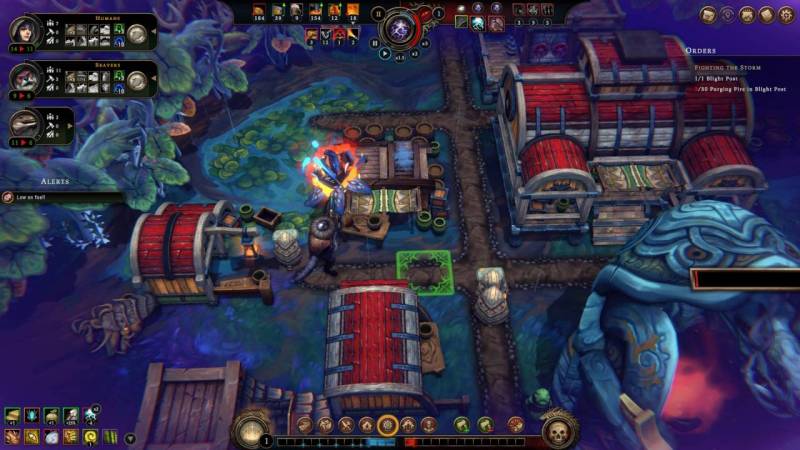
Burning passion
Against the Storm Narrative and Game Cycle: “Yes, My Queen”
The narrative isn’t too complex, but it is the engine within which the other cycles make sense as a whole. You are a collection of humans, beaver people, bird people, and reptilians (not the Zuckerberg kind, actual dinosaurs). There will be a 5th species in the future according to the developers, but you are all united by the fact your world is ravaged by blightstorms. The only thing that keeps civilization functioning is a series of expeditions to gather resources in between these apocalyptic hurricanes.
Your Queen reigns from a sanctuary known as “the Smoldering City” that exists at the epicenter of these storms, and your expeditions keep the shield up and your fellow citizens alive. As a player, you take the role of a Viceroy, who functions as the Queen’s arms, eyes, and legs. Your job is to lead the small groups of settlers into the forests and deliver to the Queen what she demands. That’s pretty much it.
Dancing along the tapestry woven by this aforementioned narrative, the actual core gameplay loop occurs at several distinct “strata” that weave into each other pretty cohesively. Starting with:
Core Strata: Your Current Settlement
This is where the proverbial magic happens, and subsequently, there is a lot to talk about. At the beginning of every expedition, you get to pick where you will settle.
The hex grid shows what resources you will acquire to improve your home city should you successfully accomplish the Queen’s demands. You can also see what particular randomized effects you will be subjected to while you struggle against the wilds. Taking note of these can mean success or failure, so learning how these impact your settlers is key.
In a nutshell, you start off every map in a singular glade with a hearth and a storage depot. The depot is self-explanatory, but the hearth is your own mini-version of the Smoldering City shield. Failing to keep it fueled can lead to absolute disaster, so better get chopping!
Feeding your villagers is just as important as the fire, so you will quickly run out of what resources are available within your initial glade. You must also take care to mind your villager’s various resolve levels, represented by a green bar around the character icon in the top left of the screen. If it’s high, you get more rewards and progress, while if it’s too low, villagers start bailing on your colony.
I’ll get into it in more detail later, but maximizing your resources to craft foods and activities that each species of colonists will respond positively to is integral to making sure they stick around.
Cutting through the surrounding trees will clear the fog and allow you to harvest the surrounding pockets for resources. However, perhaps due to the blightstorm or some sort of whacky magic, the forest is alive, the forest is powerful, and the forest absolutely hates you.
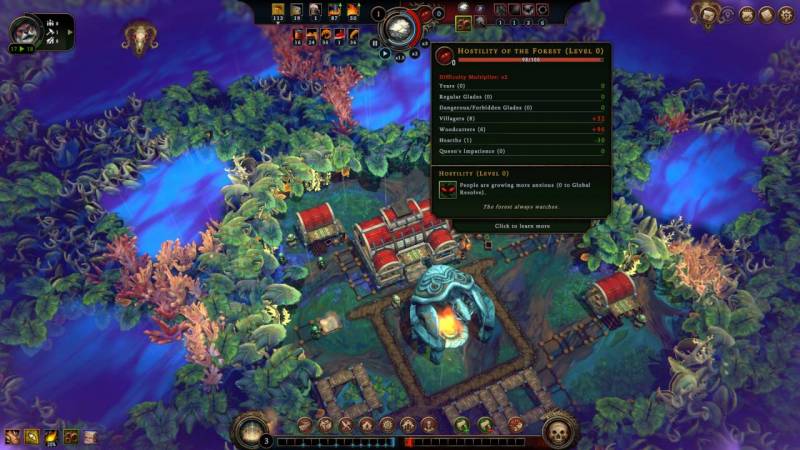
The humblest of beginnings
Through various causes, the forest’s hostility will increase pretty rapidly. Some factors are pretty straightforward, such as years spent in the forest (three portions in a year: drizzle, clearing, and storm) and how many villagers you have. Woodcutters will anger the forest more (which totally makes sense to me), as will opening up surrounding glades.
Some glades have skulls on them, indicating a potential danger that will require resources to solve before their timers run out, but these increase forest hostility more dramatically than regular ones.
When forest hostility rises, in addition to standard resolve debuffs on your villagers during the storm, extra negative modifiers begin to take effect. These can get extremely bad, as the last thing you need while dealing with resolve penalties is a separate effect that slows your villagers in their production.
Now, this all sounds pretty serious, but what’s weird is that the storm’s increasing hostility isn’t even the most important clock you’re racing against.
That honor is given to the little red bar at the bottom of your screen. Graciously anointed with a skull logo, this is the “Queen’s Impatience” meter.
For smooth brains like myself, the most simple way to look at it is that you need to fill up the blue on the left before the red on the right. The Queen offers you blueprints for buildings, additional villagers, and special modifiers called cornerstones; but if you don’t achieve her goals or, at the very least, produce a happy colony, she will end your run.
How do we impress our Queens, you ask? Well, just like we impress our Queens (or Kings or whomever’s), we give them whatever they ask for.
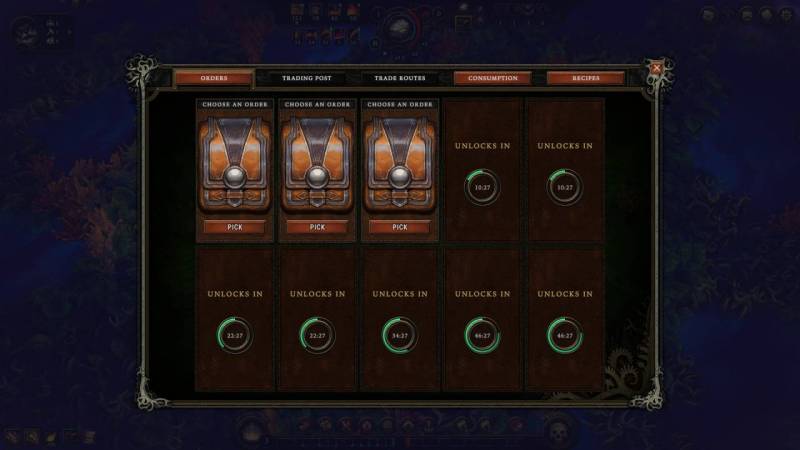
Think of these as vital as remembering your partner’s anniversary or birthday
The most direct way to fill up that blue bar (reputation) is by completing orders. These unlock at set intervals, but you get three at the very start of each run. These are random (this word is going to come up a lot, bear with me), but the initial ones are easier to accomplish.
An example could be to have a “trading post” structure built and 10 amber (currency) in the settlement coffers. Upon turning in an order, you will get several rewards like resources or, on rare occasions, a blueprint, and you will also fill up one segment of the blue bar. What complicates this whole process is that, very much like the orders, the structures you are able to build to harvest resources and craft goods are completely random as well!
You’ll notice on the blue bar there are little nodes under some of the segment dividers, these indicate when you will be given the opportunity to draft a new blueprint. You get three to start with and eight on the bar; each draft gives you four randomized structures to choose from.
This is where you have to start rubbing your two brain cells together because you will have to make the decision of which choice might be valuable now and which may be valuable in the future, depending on your goals.
For example, look at the image below. The average thought process may go like this: let’s say that there is an abundance of copper nodes on the map. Copper bars are a valuable resource that are obviously crafted from copper nodes, so maybe a Smelter would be advantageous.
But wait! Perhaps it would be preferable to prioritize making coats out of fabric for your people to get a small resolve boost, and you should pick the Clothier instead!
WAIT! A bakery makes biscuits AND pies, meaning your needs for complex foods will be easily satisfied as soon as you find flour!
So on and so forth, every decision is haunted by the opportunity cost of what you didn’t take.
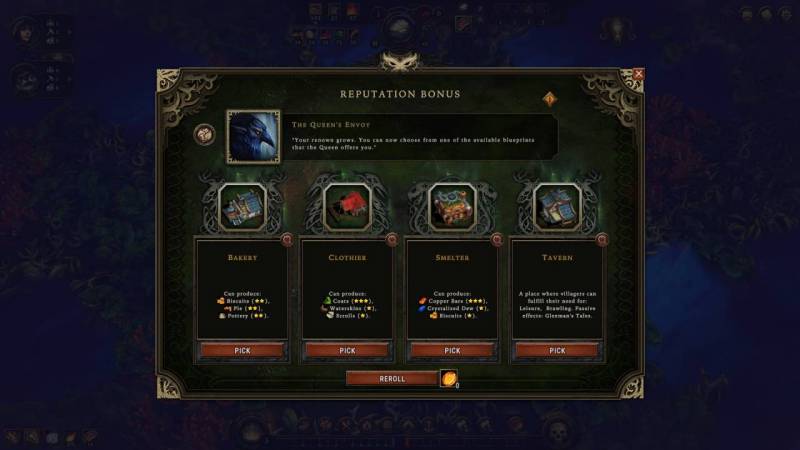
The little stars indicate how efficient a production order will be. More stars, fewer raw materials required
Now, this is where it gets extra fun.
As far as I can tell, picking a particular building does not guarantee that you’ll get a synergistic one in the future. It is entirely possible that you pick the tavern in the above picture because you hope to satisfy your settler’s recreation needs but never get the opportunity to draft a blueprint that produces ale!
In another totally plausible scenario, maybe you draft the Clothier with the expectation of being able to weave coats out of fabric. However, upon running out of your initial batch of fabric, you are unable to find another viable source of materials to create it!
To top it all off, perhaps the Queen’s next order gives you two choices; one demanding you provide coats and the other demanding you provide ale! You get the idea, you’re at the whims of a mad god called chance.
Again, these “rogue” elements are what truly sets this genre apart. It’s akin to a gigantic puzzle where you have to think on your feet and do your utmost to satisfy the Queen’s demands as best you can with what is being provided to you — or find another way to do so if you can’t.
So let’s say you’ve been shafted, and you can’t fulfill the current loadout of orders. Well, don’t fret, the next easiest way to fill up your reputation bar is by increasing your settler’s resolve.
As mentioned, there are (as of now) four separate species that can join your colony, and the ONLY thing they will all have in common that grants them a resolve buff is that they require shelter. Shocking revelation.
Other buffs may be shared between two or three races but never all four. For example, humans and beavers like consuming biscuits, but lizard people and bird people will not. Instead, they will prefer skewers as a complex food option.
You will only ever get three types of villagers per expedition, but the needs they share and don’t share are something you need to be cognizant of when planning your settlement and drafting your buildings.
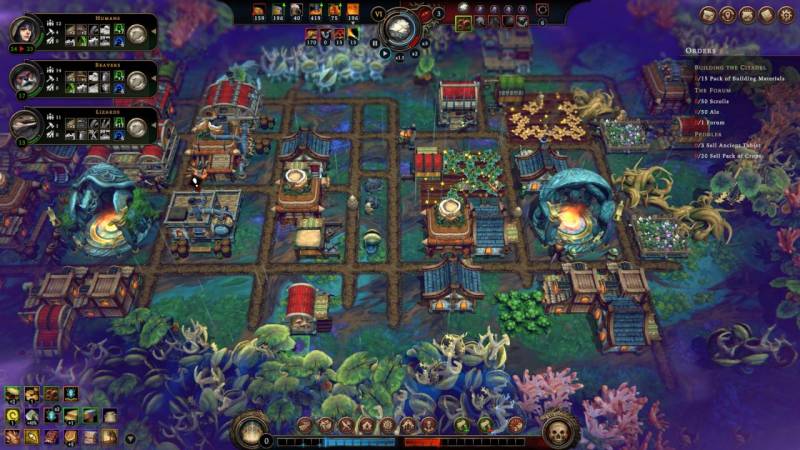
Look, it’s not attractive, but it works
Typically these shake out in the following broad categories: shelter (duh), specialized shelters per race, complex foods/items, and service activities.
For complex foods/items, you will need to produce them yourself. Very straightforward, use meat and a fuel source to make jerky. Service activities require a special building that has to be drafted, in addition to producing a complex resource to fuel it.
Think of a temple: it can provide a religion bonus to your humans and your lizard people, but to run optimally, you need to stick three villagers in there to operate it and have a hefty supply of incense ready to rock. This is a huge resource sink, but the benefits are likewise hefty.
Cobbling together a supply chain as best you can is as much planning as it is improvisation. Sometimes your chains will sparkle and shine, but half the time, they’ll be jury-rigged from pieces of barbed wire, your neighbor’s fence, and an old shoelace. Don’t get discouraged, though, being pretty is overrated.
Despite all this yammering on about logistics, you don’t need to have been that guy in econ class who knew the difference between elastic and inelastic products on day one.
What you will need to keep an eye on is the basics of supply vs. demand; as obviously, the more settlers you have consuming something, the more you will need to produce to get the benefit.
Pathing is also important because villagers need to deposit these items into warehouses for them to be usable. Placing your buildings and depots in the most efficient way shaves off milliseconds, and that adds up over time.
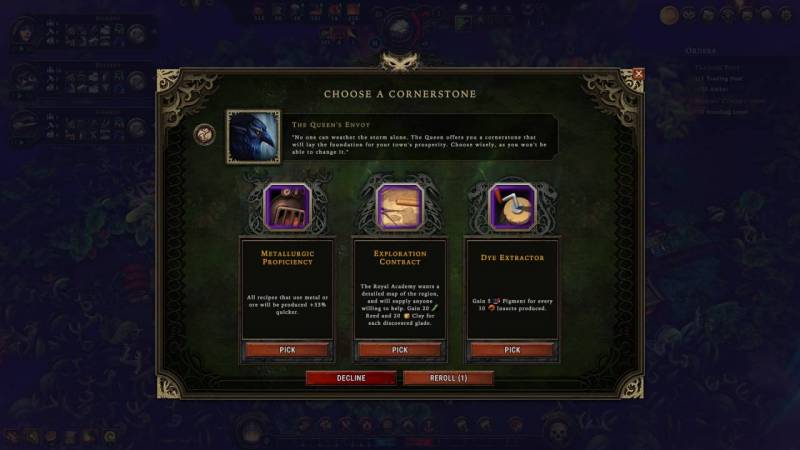
I save my rerolls until midgame, where I’ll have some idea of what the settlement will specialize in
The last core aspect that is given to you randomly from a pool are your “cornerstones.” As the name suggests, cornerstones are the pillars upon which your little hamlet gains their uniqueness over the others.
Stop me if you’ve heard this one before: from a set of three options, you will decide, based on your circumstances, geography, and your playstyle, what works best.
In the image above, I would take the “Exploration Contract” most of the time because I like to show the forest my ass and expand into as many glades as possible out of sheer spite. However, if you have copper nodes lying about, it may be best to take Metallurgic Proficiency so that you can pump out copper, coal, and crystalized dew more quickly.
You get a new one of these after every year passes (again, after the cycle of Drizzle, Clearing, and Storm), so you’ll be able to stack up quite a few of these in the bottom left corner of the screen. My personal favorites are the ones that reward trading.
You can send goods in exchange for amber currency, and I found adding the extra benefit of increasing my resolve or reputation WHILE getting money too good to pass up.
Who complains about getting paid twice? Exactly.
In summary, for this section, there’s a lot of RNG (Random Number Generation) involved in terms of what you are able to do, but you can typically find your way out of a hole if you give it a think. This balance is essential, and I will get into more in-depth thoughts toward the end of the review.
Against the Storm World Cycle/Smoldering City Progress
Let’s take a deep breath together, shall we, that last section was dense. *Breathes in and out rapidly into a bag*
Now that we’ve gotten that out of the way let’s talk about the next strata: The Overworld
As mentioned, the bulk of your gameplay will occur on the small maps struggling as the forest tries to evict you, but the overworld is arguably more important. Despite looking like a tall glass of water in the desert, the Smoldering City isn’t just there as eye candy.
By completing your expeditions and establishing functional colonies, you are able to invest bread, gears, and artifacts into buildings that improve your ability to colonize an unforgiving world.
These are roughly organized into themed upgrade chains, meaning consistently upgrading your “Dim Square” will give you similar benefits.
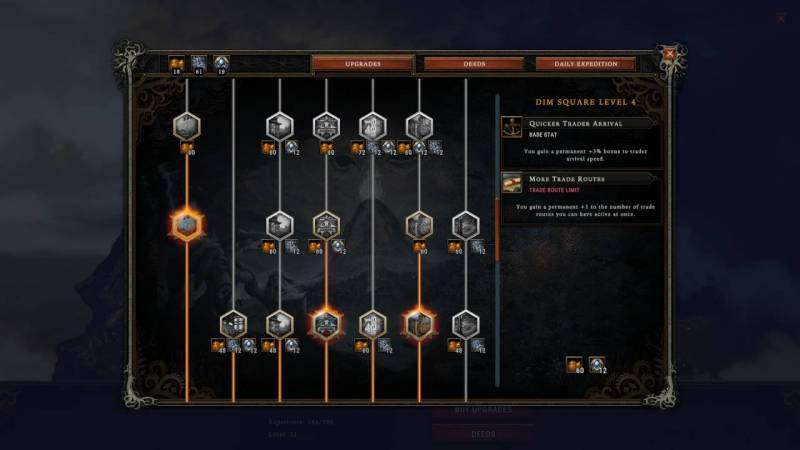
If I lived here, this is the district I’d reside in
Each upgrade will normally provide you with some small percentage-based modifier that makes a process more efficient. “Dim Square” makes traders arrive 3% faster while another makes villagers move 2% faster. To say the least, these can seem unsexy, but that’s bush-league thinking.
In any production/logistics chain, every small efficiency boost adds up in the long run, and even subconsciously, you’ll notice the game gets a little easier and a little smoother as time goes along. These upgrades impact EVERY FUTURE COLONY you establish, so it helps to prioritize which features you’d like to focus on first.
As a little bonus, when you construct a new building, it actually appears on the main city screen. This adds nothing in terms of overall mechanics, but I found it really cute and applaud this design choice.
The final interaction that takes place at this strata is picking where your settlement will be located.
It’s quite simple; each tile allows you to collect the resources in a 7-tile honeycomb. The tiles all have their own environmental effects and biomes that will change the way you play based on what becomes available.
There are points of interest scattered around the map. If one of them falls within your honeycomb, you will be subjected to an additional modifier to your colony.
At the bottom of the map screen, you’ll notice there is a bar that slowly fills up with purple. This corresponds to the number of years you have been building colonies around the map in your current storm cycle.
At the end of that bar, a blightstorm rolls in and wipes the map clean. When the storm dissipates, you’ll start fresh with a new map and new points of interest uncovered by the cataclysm.
These two systems add yet another layer of randomness to an already very tall metaphorical cake.
As I said above, the sheer scale of how many different elements there are means that it’s incredibly unlikely that you’ll see the exact same combination of features in your game seed. This is what keeps the people coming back and the gameplay loop engaging.
So all this being said, how did they do?
Yes, Quit Rambling! What’s the Assessment?
Rating a game in Early Access can be difficult in a vacuum. As mentioned, Against the Storm is undergoing scheduled content updates, and almost all of them are suggested by their community.
A fair few of the things I’ve had issues with will likely be noticed by this community/developer team and updated or patched out in the coming months. However, I think even having this level of engagement with your customer base is a great sign of a game’s health.
We’ve seen it time and time again where companies will release barely functional pieces of shit that are just good enough because people will buy them anyway.
It’s clear to me in this instance that this team is prioritizing polishing this game and making it fun, which goes a long way in my book. They’ve indicated that the public roadmap isn’t even the entirety of what they are hoping to implement, and I’m genuinely eager to see what they will incorporate next.
They’ve hosted community brainstorms for features, rapidly deploy bug fixes/patches, and from what I can ascertain, are pretty active on their Discord server.
Let me just say that right off the bat, I love this level of interaction and engagement.
It’s been about 3600 words so far, and you might have guessed that I very much enjoyed the time I put into it. There were a few nitpicks that I did have, and again I’m aware that these may be patched out soon or suggested by the community in the past.
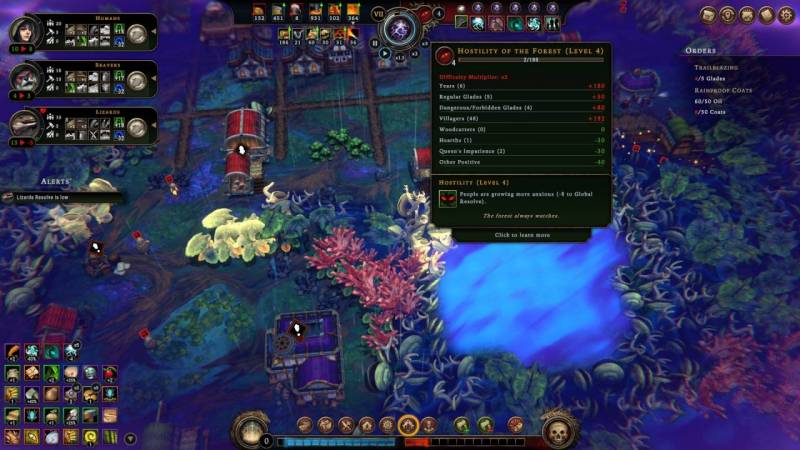
My middle name is “danger”
When you’re playing a “rogue” game, there needs to be a balance in the pool of unlockables you can draw from.
Having too few options means that the game gets stale fast but having too many options means that it’ll be harder to MacGyver a winning solution from your box of scraps.
In this case, I felt the selection of goods/buildings was, by and large, a strong balance between having not enough variety and too much variety, as I was generally able to figure out a way around not having an optimal blueprint catalog to still come away with a win.
I’d, of course, like to see them expand the resource and produced goods library while keeping this balance going, but at a gradual and methodical pace. Give me more, please!
Where I did think they needed more variety urgently was in the biome modifiers and the events found in the “dangerous glades.”
After the 40-hour mark, I felt like I had seen enough of the maps to not get too excited about the impact a biome would have. I basically started prioritizing the ones that give a special additional resource per tree cut down and moved forward from there.
Likewise, with glade events, most of them were very ho-hum in terms of rewards, so I normally picked the amber and reputation bonus by default to get me the W.
A little upgrade in both these categories would go a long way in terms of player retention. This is currently my largest nitpick with the game so far, in that I want to see more, get more, and experience more while conquering the forest time and time again.
For “ease of use” updates, I’d like them to make some of these buildings easier to identify at a glance. I understand the buildings are color-coded based on their role and have bits and bobs that animate the production cycle, but from a top-down view of a sprawling settlement, it can be difficult to identify quickly.
Maybe providing the Viceroy with the ability to designate certain buildings as part of a particular production chain in a Pantone of their choice would be a happy compromise.
I would also love there to be a way to click on a resource node and see exactly what in your current settlement is utilizing this resource.
Sometime during the Early Access cycle, the developers kindly put together a recipe book that details what is made from what. This joins the list of cornerstones and blueprints to make up a very robust in-game encyclopedia.
You can see what buildings in your current colony produce a certain resource, but unless I’m mistaken, I have yet to identify how I can click on a newly discovered resource node to get a refresher on how that resource is currently being used in my colony.
These roots are being used to make packs of crops, but maybe I’ve forgotten they’re being turned into flour as well. Therefore, this would give me an idea of how many villagers to expend foraging these materials when I can visually see the demand.
Along this vein, I’d love to be able to click on a resource at the top center left of my screen and see an almost Bloomberg terminal layout of what the building is currently using and at what pace.
I’ve sometimes lost track of resource procurement and had almost none left because several buildings were guzzling it down. If I could see a chart and notice where it dipped, I’d be able to identify which production cycle to slow down or better optimize.

You unlock more buildings as you level up as well, so the ones you get at the beginning of the game may get phased out by the player
The road map indicates they are overhauling the mining and the blightrot (corruption that builds up per production cycle on veteran+ difficulty) systems, which is great, and I am applauding the initiative. These systems do seem a bit shallow, and I’d love to do more with them.
I’d also be interested to see if they could make the farming/gathering systems a little more versatile in the early game. Farms can only be built on fertile ground, and I’ve noticed that sometimes this can be impossible to find.
Around 4 separate buildings can get “bricked” and unusable if you don’t find these fertile patches, so hopefully, a way can be implemented to gain access to tillable ground.
I understand allowing the player to create it of their own volition would flatten the difficulty curve, but perhaps there could be a building that converts other resource nodes into fertile ground. The cost should obviously be high and the process inefficient, but that’s up for the player to gauge for themselves.
Just an idea off the top of my head to improve the early meta game a little.
Another thing that threw me a little was how the various base foraging camps were so specialized that it was almost comical.
At the beginning of each “run,” you’re given a few basic camps that can gather up the resource nodes lying about, but rarely can they cross-collect. This makes sense that a “stone cutter camp” can’t gather up broccoli, but are you REALLY telling me that my “scavenger camp” has no capacity to pick up these vegetables? Is the equipment so niche that it’s only good at gathering eggs and roots?
This is probably for gameplay balance purposes, and the developers obviously know what they’re doing, but I found it quite funny at the concept, so had to write it down.
Maybe through some clairvoyance, as I was putting the final touches on this review, the developers may have addressed this issue. On 12/8/2022, an update went out that allowed “small” versions of resource camps that you can use to harvest (albeit inefficiently) some of the more specialized resources (like berries, meat, and vegetables) in your glades.
I’ll have to test it out more, but I think it’s a good step in the right direction. Not shutting down your Viceroys entirely, but making the process inefficient enough so that in order to make anything scaleable, they’ll have to invest in more refined buildings. I’m leaving my original commentary because the experience of yelling at my settlers to “JUST PICK UP THE DAMN BROCOLLI” was quite amusing to me.
These are just some of nitpicks I noticed, but as a whole, they DO NOT diminish from what is a charming game, which brings us to …
Final Thoughts on Against the Storm
I’m giving this a good mark even if we, in theory, have no idea how this game will evolve in the coming months. Against the Storm is an intriguing twist on a classic rogue game structure, and I think a lot of attention was given by the development team to ensure not only a balanced but engaging game as well.
Based on the evidence, this is the kind of team you want to put your money behind, one that actually cares. I think that there is a very good chance that they will continue this line of quality in the future.
At almost 50 hours, I think I’ve got a pretty good picture of what the current experience is like. I’m nowhere near done with the Smoldering City upgrade tree, so I haven’t done it all, but I’ve seen enough to place my belief here. At 96% positive reviews on Steam at the time of writing this, I’m certainly not alone.
While I move on to other projects, I’m making a mental note to come back in 3-4 months and see what wonderful stuff they’ve whipped up.
At 20 bucks, I’d definitely recommend giving this a look if you like settlement builders, RNG or rogue mechanics, and/or appealing visuals (the settlers are so darn cute). Against the Storm isn’t the most complicated of games out there, but it does what it does well and hopefully should only get better as more get added. Keep up the good work, Eremite Games!
Against the Storm sells for $19.99; it is available from Steam and Epic.
Source: Developer/Publisher supplied review code
What I Like: The randomness is balanced, as you can typically find your way out of a jam with regularity if you think; Community engagement during the development process; Polished experience with cute visuals
What Needs Improvement: Needs more variety in a few elements to keep people engaged long term; Some systems are a bit too shallow at this time, e.g., mining, blightrot, farming

